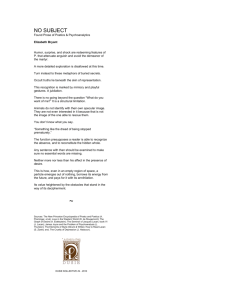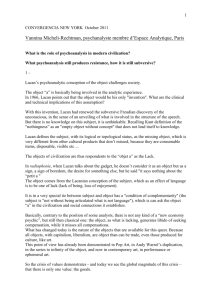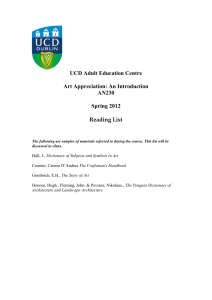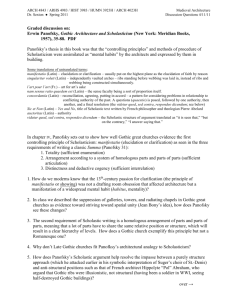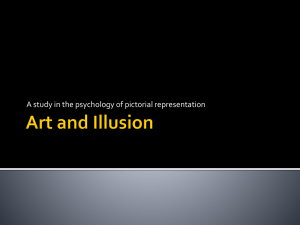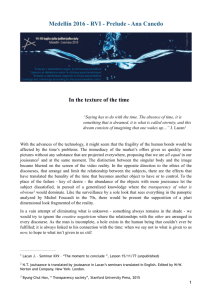Linear perspective is a systematic method for representing space on
advertisement
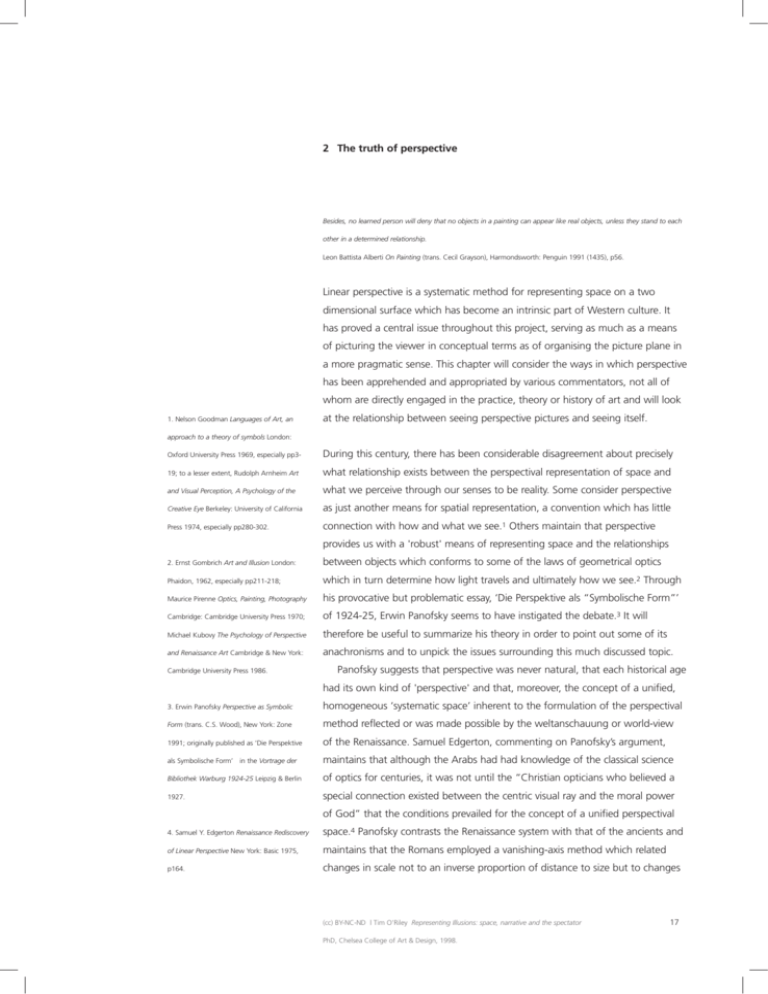
2 The truth of perspective Besides, no learned person will deny that no objects in a painting can appear like real objects, unless they stand to each other in a determined relationship. Leon Battista Alberti On Painting (trans. Cecil Grayson), Harmondsworth: Penguin 1991 (1435), p56. Linear perspective is a systematic method for representing space on a two dimensional surface which has become an intrinsic part of Western culture. It has proved a central issue throughout this project, serving as much as a means of picturing the viewer in conceptual terms as of organising the picture plane in a more pragmatic sense. This chapter will consider the ways in which perspective has been apprehended and appropriated by various commentators, not all of whom are directly engaged in the practice, theory or history of art and will look 1. Nelson Goodman Languages of Art, an at the relationship between seeing perspective pictures and seeing itself. approach to a theory of symbols London: Oxford University Press 1969, especially pp3- During this century, there has been considerable disagreement about precisely 19; to a lesser extent, Rudolph Arnheim Art what relationship exists between the perspectival representation of space and and Visual Perception, A Psychology of the what we perceive through our senses to be reality. Some consider perspective Creative Eye Berkeley: University of California as just another means for spatial representation, a convention which has little Press 1974, especially pp280-302. connection with how and what we see.1 Others maintain that perspective provides us with a 'robust' means of representing space and the relationships 2. Ernst Gombrich Art and Illusion London: between objects which conforms to some of the laws of geometrical optics Phaidon, 1962, especially pp211-218; which in turn determine how light travels and ultimately how we see.2 Through Maurice Pirenne Optics, Painting, Photography his provocative but problematic essay, ‘Die Perspektive als “Symbolische Form”’ Cambridge: Cambridge University Press 1970; of 1924-25, Erwin Panofsky seems to have instigated the debate.3 It will Michael Kubovy The Psychology of Perspective therefore be useful to summarize his theory in order to point out some of its and Renaissance Art Cambridge & New York: anachronisms and to unpick the issues surrounding this much discussed topic. Cambridge University Press 1986. Panofsky suggests that perspective was never natural, that each historical age had its own kind of 'perspective' and that, moreover, the concept of a unified, 3. Erwin Panofsky Perspective as Symbolic homogeneous ‘systematic space’ inherent to the formulation of the perspectival Form (trans. C.S. Wood), New York: Zone method reflected or was made possible by the weltanschauung or world-view 1991; originally published as ‘Die Perspektive of the Renaissance. Samuel Edgerton, commenting on Panofsky’s argument, als Symbolische Form’ in the Vortrage der maintains that although the Arabs had had knowledge of the classical science Bibliothek Warburg 1924-25 Leipzig & Berlin of optics for centuries, it was not until the “Christian opticians who believed a 1927. special connection existed between the centric visual ray and the moral power of God” that the conditions prevailed for the concept of a unified perspectival 4. Samuel Y. Edgerton Renaissance Rediscovery space.4 Panofsky contrasts the Renaissance system with that of the ancients and of Linear Perspective New York: Basic 1975, maintains that the Romans employed a vanishing-axis method which related p164. changes in scale not to an inverse proportion of distance to size but to changes (cc) BY-NC-ND | Tim O’Riley Representing Illusions: space, narrative and the spectator PhD, Chelsea College of Art & Design, 1998. 17 in the visual angle of sight. This, he proposes, is based on the knowledge that 5. Panofsky, op. cit. p57. John White draws on the retinal image is not rectilinear but curved owing to the concavity of the inside Panofsky’s notion of ‘symbolic form’ (pp123- of the eye and that the ancients, therefore, employed a curved plane of intersec- 125) and explores Leonardo’s concept of curvi- tion as opposed to the rectilinear plane of Albertian perspective. Such a method linear or synthetic perspective in Chapter XIV precluded a single vanishing point, hence the vanishing-axis principle. Moreover, (pp202-218), The Birth and Rebirth of Pictorial he claims that antiquity had no need of a ‘systematic space’ as its world-view Space London: Faber & Faber 1967. did not conceive of a unified spatial continuum. Panofsky cites the theories of Democritus, Plato and Aristotle in order to show that the antique view of spatial- 6. Panofsky, op. cit. p66. ity as the gap between objects does not recognize the possibility of the “homogeneous, infinite system of dimensional relationships” of the Renaissance: “... for 7. Damisch has proposed that perspective the discovery of the vanishing point as ‘the image of the infinitely distant points could be regarded as both an object of truth of all the orthogonals’ is, in a sense, the concrete symbol for the discovery of the and as an object of knowledge. He maintains infinite itself.”5 The importance, for Panofsky, of Alberti’s constructive procedure that it is not a code but that, with regard to lies in the notion that by determining depth intervals correctly, it interpreted linguistic construction, it institutes a point of the interaction of the visual pyramid with the picture plane, and by extension, view analogous to the 'subject' or 'person' vision itself, in constructive, geometric terms: “the subjective visual impression posited in relation to a 'here' or a 'there'. In was indeed so far rationalized that this very impression could itself become the this sense, perspective could perhaps be foundation for a solidly grounded and yet, in an entirely modern sense, ‘infinite’ seen and used as an 'expressive apparatus'. experiential world.”6 It is necessary however to make a distinction Panofsky's theory of perspective based on retinal curvature and, indeed, between how the system was used during the his identification of perspective’s ‘truth’ with the rationalisation of the subjec- Renaissance and how it has been interpreted tive visual impression, has been demonstrated to be incongruous although his by later theoreticians and artists. Kubovy's concept of perspective as symbolic form still proves a contentious issue and argument that Renaissance artists such as continues to exert an influence.7 Indeed the concept of the light-sensitive retina Mantegna and Leonardo were implicitly aware seems to belong more to modern scientific understanding than to Renaissance of the metaphorical potential of the perspec- or antique theories of representation and is perhaps anachronistic when used tival system and incorporated it into their in a discussion of such systems. In a polemical paper which criticizes Panofsky work - such as the former's St James Being for what he believes is a misreading of Alberti’s achievement, Joel Snyder inter- Led to Execution - is perhaps a good example prets the latter’s De Pictura as an imaginative leap, informed but not dictated of such an interpretation. See Damisch The by improved scientific knowledge about the nature of optics, in which vision is Origin of Perspective and Michael Kubovy The modelled pictorially.8 Whilst the link between perception and the perceived object Psychology of Perspective and Renaissance Art is physical in that the array of light reflected by the object has a causal relation- Cambridge & New York: Cambridge University ship to the retinal image, for Snyder, the brilliance of Alberti’s theory is that he Press 1986, pp137-149. also makes an imaginative link by conceptualizing vision in terms of pictures. In addition to the development of a drawing tool which incorporated knowledge 8. Joel Snyder ‘Picturing Vision’, The Language about perspectiva, the science of optics, Alberti’s achievement was to imagine of Images (ed. W.J.T Mitchell), Chicago & the mental image as a picture and to provide a method for logically and correctly London: Chicago University Press 1980, projecting that picture. The resulting image (of an object, for example) acts on pp219-246. one’s perceptual array in the same way as the actual object would when seen (cc) BY-NC-ND | Tim O’Riley Representing Illusions: space, narrative and the spectator PhD, Chelsea College of Art & Design, 1998. 18 from the relevant viewpoint. The debate surrounding perspective’s ‘truth’ centres on the question of whether it is a conventional or a natural system. Panofsky’s interest in Ernst Cassirer’s Neo-Kantian philosophy locates this question in the broader philosophical context of the opposition between Rationalism, or more precisely, Idealism, and Empiricism. The former position maintains that the objects immediately known through the perception of the external world are essentially ideas and that one’s perceptions via the senses rely on an a priori intuition of space. Empiricism, on the other hand, rejects any notion of an a priori intuition and relies instead on observation, experience and induction as the sole means for establishing knowledge about the world. In terms of perspective, certain commentators have maintained that the perception of such pictures is an acquired skill and that Western viewers are practised in the habit of contemplating such pictures so much so that they may appear ‘natural’. Indeed, Maurice Merleau-Ponty has said, when discussing Panofsky’s perspective essay, that ultimately we perceive according to the representational system we adopt: “Once 9. Maurice Merleau-Ponty ‘The Experience acquired, a particular image of the world appears natural”.9 W.J.T. Mitchell is of Others’ (1951-2), Merleau-Ponty and critical of the notion that pictures constructed using artificial perspective neces- Psychology (ed. K. Hoeller), New Jersey: sarily “have a kind of identity with natural human vision and objective external Humanities Press International 1993, pp33- space” and he sees the camera as having reinforced this convention. His critique 63, p38. of what he calls Gombrich’s equivocation over perspective as either a natural or conventional system, centres on the latter’s likening of pictorial schemata 10. W.J.T. Mitchell Iconology: Image, Text, “to flexible scientific hypotheses tested against the facts of vision.”10 Bearing in Ideology, p38. mind the philosophical questions concerning the nature of perception and its relation to the external world, the problem for Mitchell here is that there is no unequivocal fact in the first place. In psychological terms, perception is as much a construction as an interpretation of experienced reality as, drawing on Gombrich 11. Gombrich Art and Illusion, pp251-252; and Goodman’s critique of Ruskin, “the innocent eye is blind”.11 More gener- Goodman, op.cit. p8. ally, knowledge, for Mitchell, is a social product, “a matter of dialogue between different versions of the world, including different languages, ideologies and 12. Mitchell, op. cit. p38. modes of representation.”12 Gombrich, however, has been at pains to counter the claim that perspective provides a completely natural picture, although in Mitchell’s view, he does not go far enough. Gombrich’s assertion is that what he calls ‘standards of truth’, that is, the criteria he uses to assess the effectiveness of a perspectival image, are not based on the questionable assumption of the picture’s correspondence with reality but on the “potential capacity of the image 13. Ernst Gombrich ‘Standards of Truth: The Arrested Image and the Moving Eye’, The Language of Images, p210. to evoke the motif”.13 Those in opposition to the ‘conventional’ theory usually adopt an empirical strategy which relies on the comparison of perceptual data with a perspectivally- (cc) BY-NC-ND | Tim O’Riley Representing Illusions: space, narrative and the spectator PhD, Chelsea College of Art & Design, 1998. 19 generated image. For example, Maurice Pirenne has shown that strict adherence to the rules of perspective will yield images which, when viewed from the centre of projection from which they were constructed, are in accordance with percep14. M.H. Pirenne Optics, Painting, Photography tions of the real objects and spaces depicted.14 A picture of an object, accurately London: Cambridge University Press 1970. constructed in perspective from a particular point of view will deliver to the eye 'bundles of light rays' which match 'bundles of light rays' delivered by the real object when seen from the same point of view. It should be stressed that such a perspective picture will only deliver the correct aspect when viewed from this specific point of view and theoretically, only from this point. Goodman, however, is sceptical as to whether a simple correspondence of light rays is enough or ‘sufficient’ to render a faithful representation, maintaining instead that represen- 15. see Goodman, op. cit. pp11-14. tation is more a matter of conveying than copying.15 In an analysis of Fra Andrea Pozzo's painting on the hemispherical ceiling of the church of St Ignazio in Rome (The Entry of Saint Ignatius into Paradise, 1691-94), Pirenne discusses the fact that when looking at pictorial representations, we are aware of both the space depicted and, as a result of binocular vision, the flatness of the picture surface. Drawing on Polanyi's notions of subsidiary and focal awareness, he maintains that when we are not aware of the picture surface as a surface (in that it may be too far away for binocular vision to have any effect, it may be an irregular surface as in Pozzo's ceiling or we may be looking at it through a peephole or as a reflection in a mirror), we perceive the objects and spaces represented as if they 16. Pirenne, op.cit. p95. were actually in front of us.16 Drawing on Pirenne's theory, Michael Kubovy proposes that perspective is a 'robust' form of representation precisely because we are aware of the picture plane. He maintains that Alberti's window onto the illusory world is unlike other windows in that it must be perceived as opaque in order for the illusion to be effective from more than one point of view: "We must perceive the window in 17. Kubovy, op.cit. p88. order to perceive the world.”17 If our awareness of the picture surface is lost, we correctly perceive the world from the centre of projection but this world will begin to appear distorted if our viewpoint changes. Awareness of the surface due to the effects of binocular vision allows us to see the picture as an artificial construction with which we collude in order to extract information about the illusory world. For this reason, we are still able to read and understand perspective pictures from a wide variety of viewpoints, hence perspective’s ‘robustness’. An interesting problem to examine is the extent to which an illusion could be seen as a failure of perception - a delusion - in that it is a misapprehension of what is actually seen, or an instance of our collusion in the process of perceiving. All perceptions are judgements established about objects, (and for that matter, paintings constructed in perspective) and bearing in mind Descartes’ experiment (cc) BY-NC-ND | Tim O’Riley Representing Illusions: space, narrative and the spectator PhD, Chelsea College of Art & Design, 1998. 20 with the enucleated eye, come about through image apprehension within the brain's networks and not as the result of light rays describing an image on the surface of the retina. Perspective will deliver the image of an aspect of the world to the eye but beyond that point, our perceptual system takes control. As Kemp has said: "The role of the 'brain' cannot be separated from the role of the 'eye' in perceiving a picture".18 Painter's perspective, then, could perhaps be seen to work as an analogy for Figure 14 what Gombrich calls optical reality but not necessarily as a model of our visual Hans Holbein The Ambassadors 1533 system. It is not an interpretation of how we see but a means of creating an image which will work on our visual apparatus in the way that the real scene 18. Martin Kemp 'Science, Non-science and would if it were actually in front of us. Gombrich's informational approach estab- Nonsense: The Interpretation of Brunelleschi's lishes what he believes are standards of truth by which the 'arrested image' (a Perspective', Art History 1, June 1978, pp134- term which he uses to incorporate the photographic as well as the perspectival 161, p157. image) can be judged.19 He proposes that the information about what can and cannot be seen by an eyewitness of an actual scene will be in accordance with 19. Ernst Gombrich 'Standards of Truth: The the information available in a perspective picture of that scene when viewed Arrested Image and the Moving Eye’, The from the appropriate viewpoint. Indeed he maintains that: "All the theory Language of Images, pp181-217. claims, is that it records the multivalent information the single eye would receive when placed at the apex of the visual pyramid. What else can we ask for?"20 20. Gombrich ‘Mirror and Map: Theories Goodman is strident in his opposition, stating that the behaviour of light in no of Pictorial Representation’, The Image and way sanctions the truthfulness of a particular method for the visual representa- the Eye, Further Studies in the Psychology of tion of space.21 Both approaches, however, are not as mutually exclusive as they Pictorial Representation Oxford: Phaidon 1982, appear as long as we do not make inappropriate claims. Where denotation is pp172-214. otherwise established, perspective provides a more or less useful and robust means of depicting space and to worry over its faithfulness is, perhaps, to put 21. Goodman, op. cit. p19. too much emphasis on the referent, on what is being depicted. Jacques Lacan talks about the perspective/anamorphic schema in Hans Holbein’s The Ambassadors (1533, figure 14) as catching the observer in its ‘trap’. He maintains that the anamorphic projection of the skull which appears across the lower half of the canvas reminds us that the painting is not “a question of a realistic reproduction of things in space” but that equated with this capture is 22. Jacques Lacan ‘The Line and Light’, The “an obvious relation with desire which nevertheless, remains enigmatic.”22 This Four Fundamental Concepts of Psycho-Analysis device exploits what Lacan calls the geométral dimension of visual space. By this Harmondsworth: Penguin 1994 (1979), pp91- is meant a conception of an aspect of the visual (epitomized in the rationality of 104, p92. the perspective system and in its counterpart, anamorphosis) as constituted by threads of sight, derived from light but not dependent on it, implying a tactile web in which the viewer is caught. He notes that the blind man of Diderot’s Lettre sur les aveugles à l'usage de ceux qui voient is capable of reconstructing (cc) BY-NC-ND | Tim O’Riley Representing Illusions: space, narrative and the spectator PhD, Chelsea College of Art & Design, 1998. 21 or imagining the demonstration of spatial relationships through the “sense of touch in his finger ends” as the geométral model has no need of light; it can 23. Ibid. p93. See also figure 7. be apprehended or imagined through the tactile.23 In a complex and enigmatic argument, Lacan proposes an alternative to the geométral dimension. This alternative could be classed as essentially visual, a dimension of vision which is characterized as that which is disclosed by light. It is defined by the point of light as a “source from which reflections pour forth”, filling, overflowing and flooding the 24. Ibid. 94. “ocular bowl”.24 In order to develop his notion of the visual as opposed to the geométral, Lacan relates an anecdote about a fishing trip taken in his early twenties, a young intellectual desperate to experience something 'practical'. On board the boat, one of the fishermen pointed laughingly to a sardine can floating in the sea and 25. Ibid. p95. said: “You see that can? Do you see it? Well it doesn’t see you!”25 Lacan recalls his discomfort with the situation, not least because he indicates the fact that he was rather out of place in the picture, an outsider having fun poked at him. He goes on to develop his disagreement with the fisherman’s exclamation by positing the argument that, in a sense, the sardine can was looking at him “at the level of the point of light... That which is light looks at me, and by means of that light in the depths of my eye, something is painted - something that is not simply a constructed relation... - but something that is an impression, the shim- 26. Ibid. p.96. mering of a surface that is not, in advance, situated for me in its distance.”26 It is this light which characterizes Lacan’s alternative visual model of space and which changes the relationship of the subject to its object. Echoing Paul Klee’s pronouncement that “now the object sees me”, Lacan proposes a reversal in which the transparent screen of Albertian perspective, interposed between the viewer and the world, becomes opaque - a screen on which is projected “a play of light and opacity”. Jay interprets this enigmatic concept as embodying a conflict within the viewing subject, “at once the eye looking at the can and 27. Jay Downcast Eyes, p365. the screen in an impersonal field of pure monstrance”.27 Lacan, however, seems to extricate himself from an implication of being in the picture, commenting that indeed, the “picture, certainly, is in my eye”. He seems to be positing a dimension of vision which embodies a reciprocal or active process of observing and being observed, in which the picture looks as much at us as we look at the picture. Bearing in mind this proposition, there is a sense in which the notion of the ‘indexical’ image, as Rosalind Krauss terms it, is related to Lacan’s distinction 28. Rosalind Krauss ‘Notes on the Index: Part between geométral and visual dimensions. Krauss talks about the index as a sign 1’, The Originality of the Avant-Garde and which establishes “its meaning along the axis of a physical relationship” to its Other Modernist Myths Cambridge, Mass. & referent.28 Just as the cast shadow bears an indexical relationship to the object London: MIT 1986, pp196-209. which casts it, so the photograph is physically related to or constituted by the (cc) BY-NC-ND | Tim O’Riley Representing Illusions: space, narrative and the spectator PhD, Chelsea College of Art & Design, 1998. 22 traces of the points of light reflected by the pictured scene. The object or scene in a sense looks at the picture plane and in doing so, creates the picture or, more 29. I will be looking at the notion of the reciprocity of looking in more detail in chapter 5. accurately, enables the creation of the picture.29 Krauss, referring to Lacan’s concepts of the ‘Imaginary’ and ‘Symbolic’ realms through which he characterizes successive stages of child development, differentiates between the photograph and the conventional pictorial image which she maintains is enmeshed within Symbolic relationships necessarily defined by language, thereby locating the image within linguistic and historical conventions. Photography is seen as somehow pre-Symbolic in its dumb relation to the world and is identified with the Imaginary realm, that is, identified with the image as opposed to language, with fantasy and with a-temporality. The problem is that such a view of photography presupposes an observer ‘as such’, a kind of given, a view that images can exist prior to language or perhaps better, prior to an 30. Joel Snyder’s discussion of perspective observer who is capable of viewing them.30 Surely W.J.T. Mitchell, writing about argues at length against the notion that the the mental image, is right in saying that if “there were no more minds, there photograph embodies a realistic relation- would be no more images, mental or material. The world may not depend on ship - or at least a more realistic relationship consciousness but images in (not to mention of) the world clearly do.”31 For the than perspective - to its subject. He sees the paradoxical nature of the image is that it is both there and not there simultane- photograph as a highly structured, manipu- ously - it is dependent on an image-conscious mind or at least a mind capable lated image of the world and briefly charts of recognising an image as an image. Indeed, as we have already seen, a picture the development of the camera as a tool with in perspective and by extension, its photographic counterpart, involves and may which to mimic and re-produce the kinds of even require both subsidiary awareness (of the picture as a surface) and foveal images developed by painters from Alberti’s awareness (of the depicted scene or objects) in order to function. Mitchell goes period onwards. See ‘Picturing Vision’, The on to say that the birds who come down to peck at the grapes in Zeuxis’ legend- Language of Images, pp219-234. ary painting are seeing real grapes not images of grapes. The metaphor is slightly unsatisfactory - admittedly he is specifically discussing the mental image 31. W.J.T. Mitchell, op.cit. p17. - as it still leaves room for the notion of a dumb image waiting for someone or something to recognize it either as an image or as ‘really’ what it represents. It is true that the photograph and indeed, the image in general when considered in a wider context, may be a less effective means of communication, more ‘dumb’ than the written or spoken word in that sometimes it may require some form of caption to contextualize it, but it still remains an image and therefore requires an image-conscious mind in order to be perceived. The idea that the pictorial image may be more steeped in the conventions of both images and language does not imply the photograph is less of an image in conventional terms, but simply that it is another type of image. Mitchell solves the problem with the following question/reply which he poses to an hypothetical observer who is not already aware of what constitutes a representational picture: “I point to Zeuxis’ painting and say ‘There, that is an image.’ And the reply is, ‘Do you mean that coloured (cc) BY-NC-ND | Tim O’Riley Representing Illusions: space, narrative and the spectator PhD, Chelsea College of Art & Design, 1998. 23 32. Ibid. p17. surface?’ Or, ‘Do you mean those grapes?’”32 Almost a century after Cubism and Einstein’s special theory of relativity, it is sometimes assumed that Alberti’s picture plane as a ‘window on the world’ has been fragmented and that both language and images are no longer the “perfect, transparent media through which reality may be presented to the 33. Ibid. p38. understanding” conceived of by the philosophers of the Enlightenment.33 A cursory look at the abundance of images based upon the perspective model in the printed media, television and film, that is, based on photography, will 34. I am not claiming that photography and show that this is not necessarily the case.34 It is perhaps ironic that nine decades by extension, film and television, produce after those events, we are re-employing a perspectival model of representation perspectival images in the manner of paintings in the new technologies of 3D computer imaging. Accounts of representation from the Renaissance onwards, but that there which invoke the uncertainties of modern quantum physics - where the act of is a relationship between them in terms of observing a phenomenon affects what is observed - may prove attractive in geometrical optics. theory but perhaps confuse the issue of visual representation which inhabits a specific context of its own. Similarly, the curvature of space may occur at a macrocosmic level where huge gravitational forces can bend the path of light, but at our cosmological level light tends to travel in straight lines and perspective pictures, by extension, seem to work tolerably well. However, if it is legitimate to now consider perspective as not just a representational method but also as an ‘expressive apparatus’ and whilst I am not suggesting that perspective was ever intended as a model of vision, it is reasonable to point out that the notion of the static, disembodied eye implicit in perspective has been absorbed into the wider contemporary picture of how we represent and perceive the world. After all, we have two eyes which constantly scan the visual world. These are as much a part of our physiological make-up as of our visual array. Indeed, some recent neurophysiological work has indicated the possibility that the reality we experience as ‘out there’ may in fact be a construction within our brains based on comparative perceptual processes. Drawing on Gerald 35. for a popular account, see Gerald Edelman Edelman’s concept of ‘neural Darwinism’,35 L.H. Finkel proposes that as a result Bright Air, Brilliant Fire: On the Matter of the of evolutionary pressures in both the environment and within our cortical ‘maps’, Mind Harmondsworth: Penguin 1994. the brain has devised a strategy for creating internal representations which are constantly refined by comparing predicted actions with their consequences. Through the “accumulated wisdom of experience”, our conception of the world orders and interacts with our perceptions of it in an attempt to match interior 36. L.H. Finkel ‘The Construction of with exterior. Furthermore, no single internal representation exists as multiple Perception’, Zone 6, 1992, pp392-405; Plato regions of the brain process discrete aspects of the perceived world (in terms ‘The Simile of the Cave’, The Republic (trans. of colour, shape, movement or depth). Finkel concludes his argument with the Desmond Lee), Harmondsworth: Penguin perhaps overly-dramatic proposition that we are still living in Plato’s cave, in the 1974, pp316-325. dark, relying (cc) BY-NC-ND | Tim O’Riley Representing Illusions: space, narrative and the spectator PhD, Chelsea College of Art & Design, 1998. 24 on internal representations - Plato’s shadows - to predict external reality.36 Or 37. David Bordwell Narration in the Fiction Film as David Bordwell notes, “we infer ‘probable worlds’ on cognitive grounds, London: Routledge 1997 (1985), p102. not purely perceptual ones.”37 In a similar vein, the random dot stereogram developed by psychologist Bela Julesz in 1959, demonstrates that the eyes and brain do not need information about surface or object contour in order to accurately perceive depth. Like perspective, such images play on a specific aspect 38. Bela Julesz Foundations of Cyclopean of our perceptual apparatus, in this case, on our ability to infer depth through Perception Chicago & London: University of disparity in the information given to each eye.38 Julesz’s computer-generated Chicago Press 1971. stereograms consist of simple geometric figures located at various illusory heights or depths in relation to the picture plane with the apparent contours of the figures ‘camouflaged’ or submerged beneath a random array of dots. When viewed appropriately, the brain is able to recognize disparities in the two views given to the eyes and despite the fact that no shape as such can be deciphered when the image is viewed monocularly, an illusion with spatial depth and contour information is reconstructed. This illusion ‘exists’ solely within the brain’s networks. Linear perspective and by extension, related viewer-centred means of representation such as photography, provide us with robust means with which to represent an image of the world to our eyes. Beyond that point, knowledge about how the brain processes optically-derived information is far from comprehensive. Turning away from methods of representation to aspects of perceiving, we can say that vision is a combination of optical, corporeal and neurological functions. In this sense, our conception and representation of space must at least acknowledge the body's role in our perception of that space. As Merleau-Ponty has said: “It is rather, a space reckoned starting from me as the zero point or degree zero of spatiality. I do not see it according to its exterior envelope; I live it 39. M. Merleau-Ponty ‘Eye and Mind’, The from the inside; I am immersed in it. After all, the world is all around me, not in Primacy of Perception Evanston: NWUP 1964, front of me.”39 p179. (cc) BY-NC-ND | Tim O’Riley Representing Illusions: space, narrative and the spectator PhD, Chelsea College of Art & Design, 1998. 25
